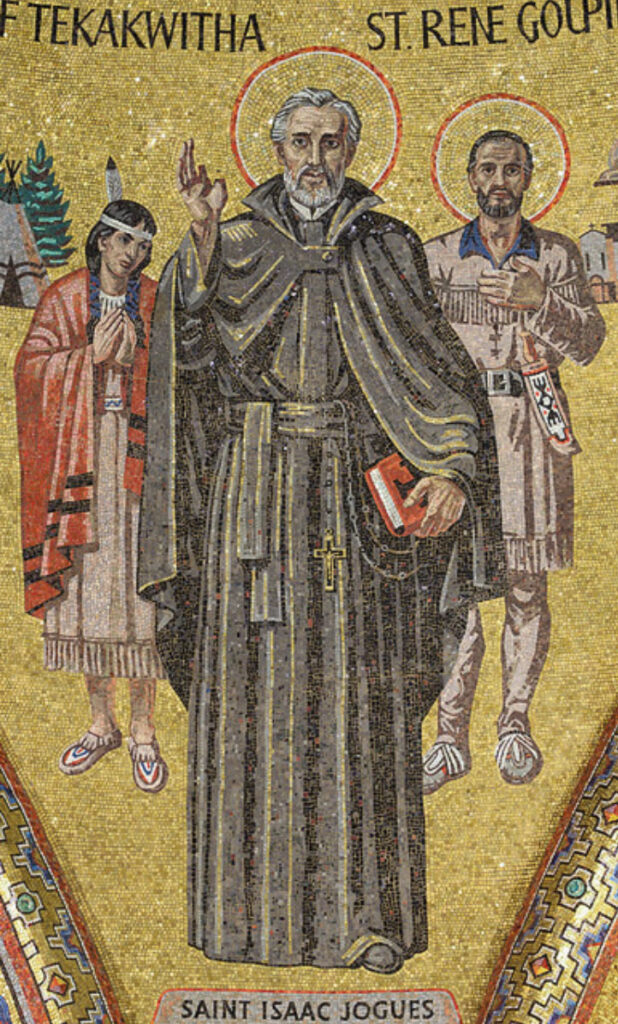
Feast Day: October 19th
North of Albany, NY and South of Montreal, Quebec lies a little lake nestled at the foot of the Adirondack mountains. It has long had the nickname “the Queen of American Lakes” because of its picturesque and tranquil waters, surrounded every autumn by glorious orange and red foliage. On the southern tip of this lake in 1755, English forces built Fort William Henry as an important step in their wresting control of the region from French control, a crucial move in the outcome of the French and Indian war (The Last of the Mohicans describes an event later in that struggle). The English would eventually take control of the Northern part of the lake as well, including its waterway up to Lake Champlain, building the famous Fort Ticonderoga on that spot, and cementing the lake’s name as “Lake George” (after King George II). Twenty years later, that fort would be the location of the first American offensive against the British of the Revolutionary War, and it would be the cannons the Green Mountain Boys captured from that fort that would later help lift the siege of Boston and turn the course of the war in the colonists favor.
But something greater than military victory was here.
That spot, between Lake George and Lake Champlain, a hundred years earlier, was the passage taken by a dozen canoes, carrying a few French Missionaries and a number of Huron Indians, returning with medical supplies from Quebec in 1642. The Huron men and women trusted the white man in the black robe who guided the lead canoe downstream. Ondessonk, they called him, “Bird of Prey”. Who could have said that the cultured boy with a decent upbringing in France would find himself at 35 years of age surrounded so far from home by such a flock. It had taken countless hours to grow accustomed to the uncomfortable crouch in that canoe, weeks to become the first white-man to hike over the Adirondacks and see Lake Superior, months to learn the languages and customs of these people he loved so dearly, and all of those prior 6 years to earn their trust.
Then the silence of oars slipping in and out of the stream was split by bloodthirsty cries as Mohawk warriors rushed on them from the woods. Isaac was the priest’s name, Isaac Jogues, and like his namesake, the son of Abraham, he could have escaped this sacrifice. He was in the lead boat, he was strong and capable from those 6 arduous years, and he was already hidden from the sight of the attacking braves, but his love was not for himself but for his friends who had been captured, and his enemies who had captured them. He had made the vow years before to give himself utterly to the call of Christ, and so he did not hesitate to sacrifice himself as a father for his children. He would endure beatings, mockings, burns, frostbite, malnourishment, flogging, and the agonizing loss of his fingernails and thumb in the months to come. Yet he still chose love. Love continuously offered to his fellow prisoners – giving them the solace, natural and supernatural, that he could – as well as love and patience for his captors – gathering wood, offering them baptism, saving the life of a pregnant mother from drowning.
Many months later, he was freed, smuggled out of the Mohawk camp and all the way back to Europe. It was Christmas, 1643, when the bedraggled, battered, missionary arrived at the Jesuit residence in Rennes, France. The Rector plied this stranger with questions about the missions of the new world, asking hesitantly “what about Fr. Isaac Jogues?” Ondessonk must have smirked as he replied: “He is at liberty and it is he, Reverend Father, who speaks to you.” The “living martyr” would receive accolades from the Pope, and permission to continue to celebrate the Eucharist despite his inability to follow all the rubrics of the Mass (because of his mangled hand). But he would give all that up to return to the Iroquois, an ambassador of peace.
3 years before he had merely faced a hard trek up to Quebec as he transversed those hills; now he faced likely death in ministering to the Mohawks. It was the day before Corpus Christi as he stood on the banks of that beautiful lake once again, and so he named it “Lac du Saint Sacrement”, “The Lake of the Most Blessed Sacrament”. For a man described as a “soul glued to the Blessed Sacrament”, who cried upon losing his hands, not from pain but from the seeming impossibility of ever again celebrating the Mass, the coming hardships were nothing compared to going without Holy Communion.
…It is this for which I beg Your Reverence to entreat Our Lord, and especially to remember at the altar a poor priest, who is about to remain 8 or 9 months without mass. It will be to me an increase of obligation to be, more than ever, my Reverend Father, your very humble and obedient servant in God
[Isaac Jogues, Letter from Montreal, September 12, 1646]

Yet he went anyway. And though without the Eucharist for all those months, he lived in his own body and blood the same sacrifice that he hungered constantly to be united to. His bravery was that of the ondessonk, his sacrifice that of the pelican, his consecration unwavering like Christ.
I shall depart in 2 or 3 days for the Iroquois journey. Still, for life, all in Our Lord.
[Isaac Jogues, Letter from 3 Rivers, September 21, 1646]
May we all give our lives as courageously, as lovingly, and as Eucharistically, as did St. Isaac Jogues.
– Fr. Dominic Rankin is a priest after Jesus Christ, seeking to be more like Him each day.